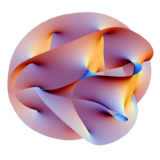Introduction to M-theory
2008/9 Schools Wikipedia Selection. Related subjects: Space (Astronomy)
| String theory | ||||||||
 |
||||||||
Superstring theory
|
||||||||
In non-technical terms, M-theory presents an idea about the basic substance of the universe.
The atom, long believed to be the smallest building-block of matter, in the early years of the 20th century was proven to consist of even smaller components called protons, neutrons and electrons, which are known as subatomic particles. Beginning in the 1960s, other subatomic particles were discovered. In the 1980s, it was discovered that protons and neutrons (and other hadrons) are themselves made up of smaller particles called quarks. Quantum theory is the set of rules that describes the interactions of these particles.
In the 1980s, a new mathematical model of theoretical physics called string theory emerged. It showed how all the particles, and all of the forms of energy in the universe, could be constructed by hypothetical one-dimensional "strings," infinitely small building-blocks that have only the dimension of length, but not height or width. Further, string theory suggested that the universe is made up of multiple dimensions. We are familiar with height, width, and length as three dimensional space, and time gives a total of four observable dimensions. However, string theories supported the possibility of ten dimensions--the remaining 6 of which we can't detect directly. These "strings" vibrate in multiple dimensions, and depending on how they vibrate, they might be seen in 3-dimensional space as matter, light, or gravity. It is the vibration of the string which determines whether it appears to be matter or energy, and every form of matter or energy is the result of the vibration of strings.
String theory then ran into a problem. Another version of the equations was discovered. Then another, and then another. Eventually, there were five major string theories, all based on a 10-dimensional universe, and all of them appeared to be correct. That was a problem, because science can't have five seemingly contradictory sets of equations to describe the same thing.
In the mid 90s, a string theorist named Edward Witten of the University of Maryland and other important researchers considered that the five different versions of string theory might be describing the same thing seen from different perspectives. They proposed a unifying theory called "M-Theory", in which the "M" is not specifically defined, but is generally understood to stand for "membrane." M-Theory brought all of the string theories together. It did this by asserting that strings are really 1-dimensional slices of a 2-dimensional membrane vibrating in 11-dimensional space.
M-Theory is not yet complete, but the underlying structure of the mathematics has been established, and is in agreement with not only all the string theories but with all of our scientific observations of the universe. Furthermore, it has passed many tests of internal mathematical consistency, which many other attempts to combine quantum mechanics and gravity failed. Unfortunately, until we can find a way to mechanically observe higher dimensions (impossible with our current level of technology) M-Theory has a very difficult time making predictions which can be tested in a laboratory. Technologically, it may never be possible for it to be "proven." However, many cosmologists, including Stephen Hawking, are drawn to M-Theory because of its mathematical elegance and relative simplicity. Physicist and bestselling author Michio Kaku has remarked that M-Theory may present us with a " Theory of Everything" which is so concise that its underlying formula would fit on a t-shirt.
Books
- Brian Greene has written books explaining string theory and M-theory for the layperson in 1999, The Elegant Universe, ISBN 0-375-70811-1 and in 2004, The Fabric of the Cosmos, ISBN 0-375-41288-3.
- Smolin, Lee. The Trouble With Physics: The Rise of String Theory, the Fall of a Science, and What Comes Next (2006), Houghton Mifflin. ISBN 978-0-618-55105-7.
- Woit, Peter. Not Even Wrong: The Failure of String Theory & the Continuing Challenge to Unify the Laws of Physics, 2006. ISBN 0-224-07605-1 (Jonathan Cape), ISBN 0-465-09275-6 (Basic Books)